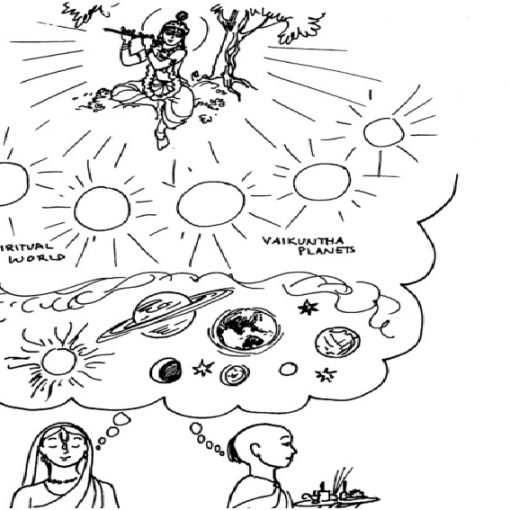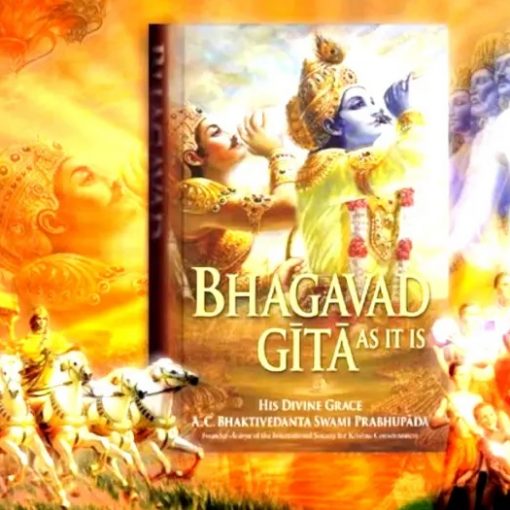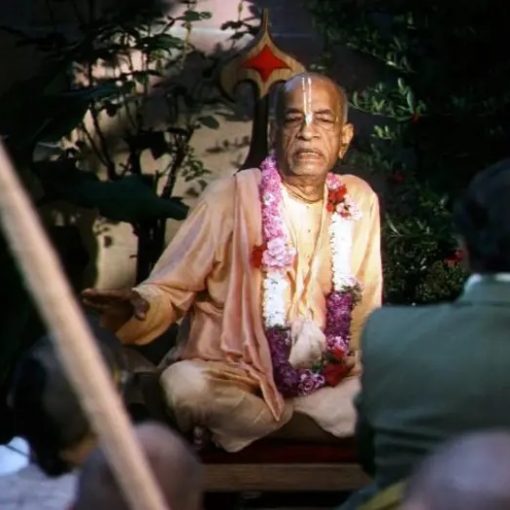Material Bondage vs. Spiritual Emotion
In the journey of spiritual practice, especially within the Krishna Consciousness (KC) tradition, terms like bhava and bhāva carry deep meanings that are essential for understanding spiritual progress and the nature of the soul’s relationship with Krishna. While these terms may appear similar, they represent fundamentally different concepts in Vedic philosophy. On one hand, bhava refers to material existence and the cycle of birth and death, trapping souls in an endless loop of suffering. On the other hand, bhāva denotes a highly advanced stage of spiritual emotion in devotion, a state that marks the soul’s near-complete realization and love for Krishna. Exploring the distinction between these two forms of bhava not only clarifies Vedic teachings but also illuminates the journey from conditioned material life to pure spiritual consciousness.
1. Material Bhava: The Cycle of Birth and Death
In the material world, bhava commonly refers to saṁsāra, the cycle of birth, death, old age, and disease. This type of bhava represents the conditioned state of the soul, where it remains entangled in the repetitive cycle due to attachments, desires, and the influence of karma. The term bhava-sāgara (ocean of material existence) is often used to symbolize the vast and seemingly endless nature of this cycle, filled with suffering and hardship.
The Root of Material Bhava
Material bhava stems from ignorance of the soul’s true nature. Conditioned by the influence of the material energy, or maya, the soul becomes identified with the temporary body and mind, forgetting its eternal relationship with Krishna. This ignorance leads to the creation of material desires, which, when pursued, result in karma. This karma binds the soul to various bodies and experiences across lifetimes, thus perpetuating the cycle of bhava in its material sense.
In the Bhagavad-gita, Krishna speaks about this entanglement: “Those who are deluded by material energy cannot see Me, the Supreme Personality of Godhead. I am never manifest to the foolish and unintelligent” (BG 7.25). Here, Krishna reveals that material attachments prevent the soul from realizing Krishna, which keeps it bound within bhava-sāgara.
Breaking Free from Material Bhava
To escape this cycle, one must transform their consciousness from material to spiritual. This transformation is achieved through the practice of bhakti-yoga, the process of devotional service to Krishna. Srila Prabhupada explains that by chanting the holy names of Krishna, engaging in scriptural study, and practicing humility, one gradually detaches from material desires and begins to transcend the modes of material nature. This transcendence leads to liberation, known as moksha, wherein the soul is freed from the bondage of repeated births and deaths.
In contrast to material bhava, which brings suffering and attachment, the spiritual path promises an elevation to a higher state of existence. This brings us to the next form of bhava, which is vastly different in its nature and implications.
2. Spiritual Bhāva: The Emotional Stage of Devotion
In Krishna Consciousness, bhāva represents an advanced stage of devotional love toward Krishna. This bhāva is a preliminary stage to prema, or pure love of God. Spiritual bhāva arises as the heart of the devotee becomes purified through sincere devotional service, allowing divine emotions and attachments toward Krishna to flourish. While material bhava binds the soul in ignorance and suffering, spiritual bhāva liberates the soul, filling it with transcendental joy and longing for the divine.
Characteristics of Spiritual Bhāva
Spiritual bhāva is characterized by deep attachment, humility, compassion, and spiritual eagerness to serve Krishna. Unlike the temporary and fluctuating emotions of material life, spiritual bhāva is steady and unwavering, rooted in pure devotion. The Srimad-Bhagavatam describes bhāva as a “softening of the heart” and the awakening of the soul’s natural affection for Krishna. This state includes ecstatic symptoms, such as tears of love, trembling, and an intense desire to serve Krishna at every moment.
In the Bhakti-rasamrita-sindhu, Rupa Goswami defines bhāva as “that stage of devotion that softens the heart and gives rise to a variety of transcendent emotions directed towards Krishna.” This bhāva is the doorway to prema, the ultimate goal of bhakti, where the devotee’s love becomes unbreakable and fully absorbed in Krishna’s service.
Types of Bhāva
Within bhāva, there are different specific emotional expressions that define the unique relationship (or rasa) that the soul shares with Krishna. These emotional expressions can include:
- Dasya-bhava (Servitude): A mood of service and reverence, seeing Krishna as the Supreme Master.
- Sakhya-bhava (Friendship): A mood of friendship, where Krishna is regarded as a close and intimate friend.
- Vatsalya-bhava (Parental affection): Parental affection, seeing Krishna as one’s beloved child.
- Madhurya-bhava (Conjugal love): The mood of conjugal love, seeing Krishna as one’s beloved.
These moods are eternal, transcendent expressions of love between the soul and Krishna, contrasting with the temporary relationships experienced in the material world.
3. Moving from Material Bhava to Spiritual Bhāva
The process of Krishna Consciousness provides a roadmap for moving from material bhava to spiritual bhāva. Srila Prabhupada emphasizes that through chanting the Hare Krishna mantra, reading scriptures, and engaging in selfless service, the heart gradually becomes purified. As one detaches from material desires, one also becomes free from the influence of material bhava (the cycle of birth and death) and moves toward spiritual enlightenment.
Prabhupada likens this process to crossing an ocean. Just as one must sail across the ocean to reach a new shore, the practitioner of bhakti must cross the “ocean of birth and death” (material bhava-sāgara) to reach the shore of divine bhāva, the beginning of pure love for Krishna.
4. Conclusion: The Ultimate Journey from Bhava to Bhāva
The terms bhava and bhāva represent two distinct stages in the soul’s journey, one in material entanglement and the other in spiritual liberation. Material bhava, characterized by the cycle of repeated birth and death, binds the soul due to karma and attachments, creating suffering. In contrast, spiritual bhāva reflects a high level of transcendental emotion and attachment toward Krishna, where the soul, free from material desires, realizes its eternal, loving relationship with the Divine.
In essence, the progression from bhava to bhāva mirrors the soul’s journey from darkness to light, from suffering to bliss, and from ignorance to the ultimate realization of love in service to Krishna. Prabhupada’s teachings remind practitioners of Krishna Consciousness that while material bhava must be transcended, spiritual bhāva must be cultivated. Through devotion, one rises from material bondage to attain a heart softened by love, yearning, and devotion, marking the soul’s final approach to prema, or pure love of God. This journey from bhava to bhāva is the core of the devotional path and the ultimate goal in Krishna Consciousness.





